Top 10 biggest flowers in the world
Nature's Grandeur: Discovering the World's Most Impressive Flowers

For millions of years, the planet's landscape has been enhanced by the presence of flowers. Through the use of color and fragrance, plants have successfully attracted insects and animals for pollination, making use of their flowers' deceptive development. Although there are numerous lovely and aromatic flowers on earth, they are frequently similar in size, measuring approximately 1 to 5 inches in diameter. Nevertheless, bright colors are crucial in making flowers visible to insects. Additionally, scent is a significant factor in plant reproduction, and many flowers have a pleasing fragrance. However, this article will only highlight plant species with a size advantage.
The following are the top 10 largest flowers in the world:
1. Rafflesia arnoldi
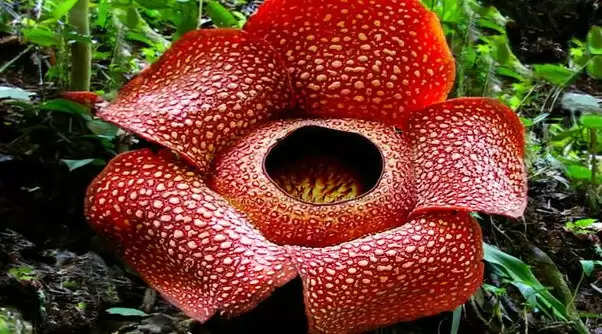
The world's largest flower, Rafflesia arnoldi, measures over three feet in diameter and is also known as the Stinking corpse lily or corpse flower. It is one of the largest living organisms and is a parasitic plant that remains inconspicuous until it is about to bloom. This plant has no roots, stems, twigs, or leaves. Over several months, buds grow to the size of a cabbage without showing any signs of the infected host plant. The corpse flower emits a foul odor, similar to a rotting corpse, during its blooming phase, and while flies gain nothing from the flowers, they are attracted to the scent and inadvertently collect pollen on their backs as they rest on the bloom. When these flies land on a female plant, they release the pollen, fertilizing it. The resulting fruit is small, fleshy, and contains thousands of seeds that are dispersed by tree shrews through excretion. Since Rafflesia is a rare unisexual plant, flies that sit on a male's flower and collect pollen have a low chance of passing it to a female for fertilization. Rafflesia arnoldi is one of the world's most endangered plant species, with certain species classified as "critically endangered" by the International Union for the Conservation of Nature (IUCN). The main factors contributing to the extinction of Rafflesian species are deforestation and the limited geographic area of the species.
2. Titan arum
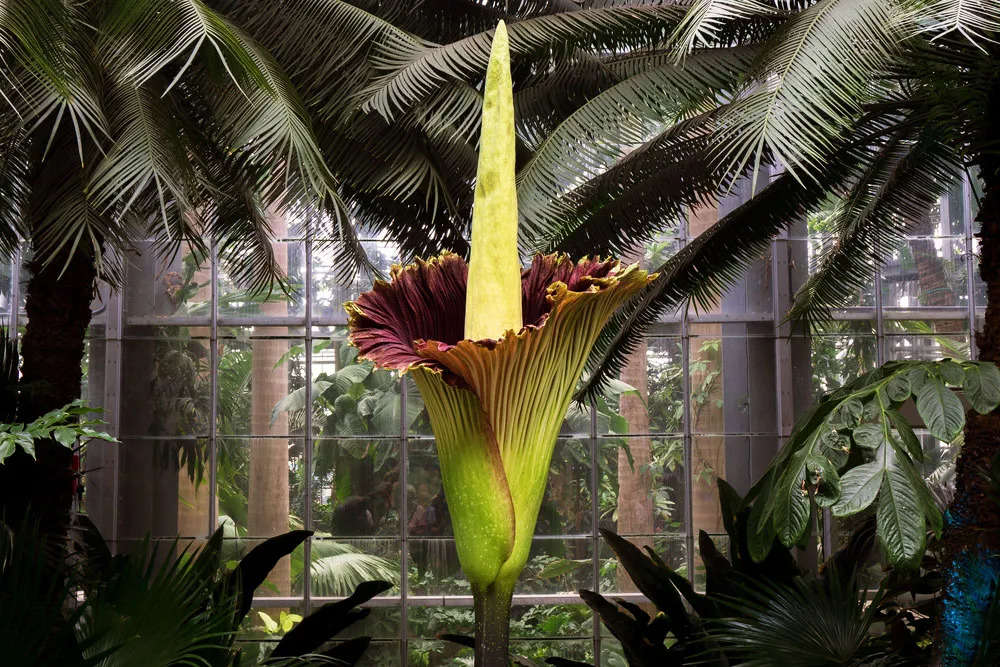
The Titan arum, also known as the Amorphophallus titanum or death flower, is a rare flowering plant with the largest unbranched inflorescence in the world. However, it is not renowned for its fragrance, as it emits an odor resembling that of a decaying corpse while in bloom. The plant can grow to be around 10 to 15 feet tall, with leaves that are as large as 13 feet. Unlike the talipot palm, the fluorescence of the Titan arum does not grow in a straight line but branches off, making it a larger flower. The Titan arum holds the world record for the tallest recorded bloom of a corpse flower, standing at 10 feet 2.225 inches. Despite its significance, the corpse flower is listed as "vulnerable" on the International Union for the Conservation of Nature (IUCN) Red List of Threatened Plants. The plant may become endangered due to habitat loss and devastation if the conditions affecting its life and reproduction do not improve.
3. Talipot palm
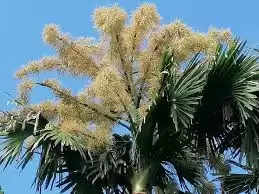
Originating from South India, the Talipot palm is one of the world's largest palms. It can grow up to 25 meters tall and have stem diameters of up to 1.3 meters. The palm fronds can have a diameter of up to 5 meters, with a petiole of up to 4 meters and around 130 leaflets. The Talipot palm boasts the largest inflorescence of any plant, measuring 6-8 meters long, with one or more million small flowers on a branched trunk atop the main trunk. Monocarpic in nature, the Talipot palm flowers only once at the age of 30 to 80. Besides being as useful as coconut in its native region, the Talipot palm has many uses, and its surprisingly tasty fruit, known as ice apples, are highly valued.
4. Neptune grass (Posidonia oceanica)

A team of scientists has recently sequenced Posidonia oceanica, commonly known as "Neptune grass," a seaweed that has been covering ocean floors from Spain to Cyprus for around 200,000 years. This plant has roots, stems, leaves, and flowers, and it produces fruits known as sea olives, but it is not an algae. Its flowering season is in autumn. The leaves are ribbon-shaped, with a width of about 1 cm and a length between 30 and 120 cm. This aquatic plant grows in the Mediterranean Sea and certain areas south of Australia, and it shares many features with land plants. Neptune grass has several benefits, including oxygenating the oceans and serving as a food source for various animal species. Its presence also indicates good water quality and proper conservation. Biologists often refer to Posidonia oceanica as the "lungs of the Mediterranean."
5. Puya raimondii
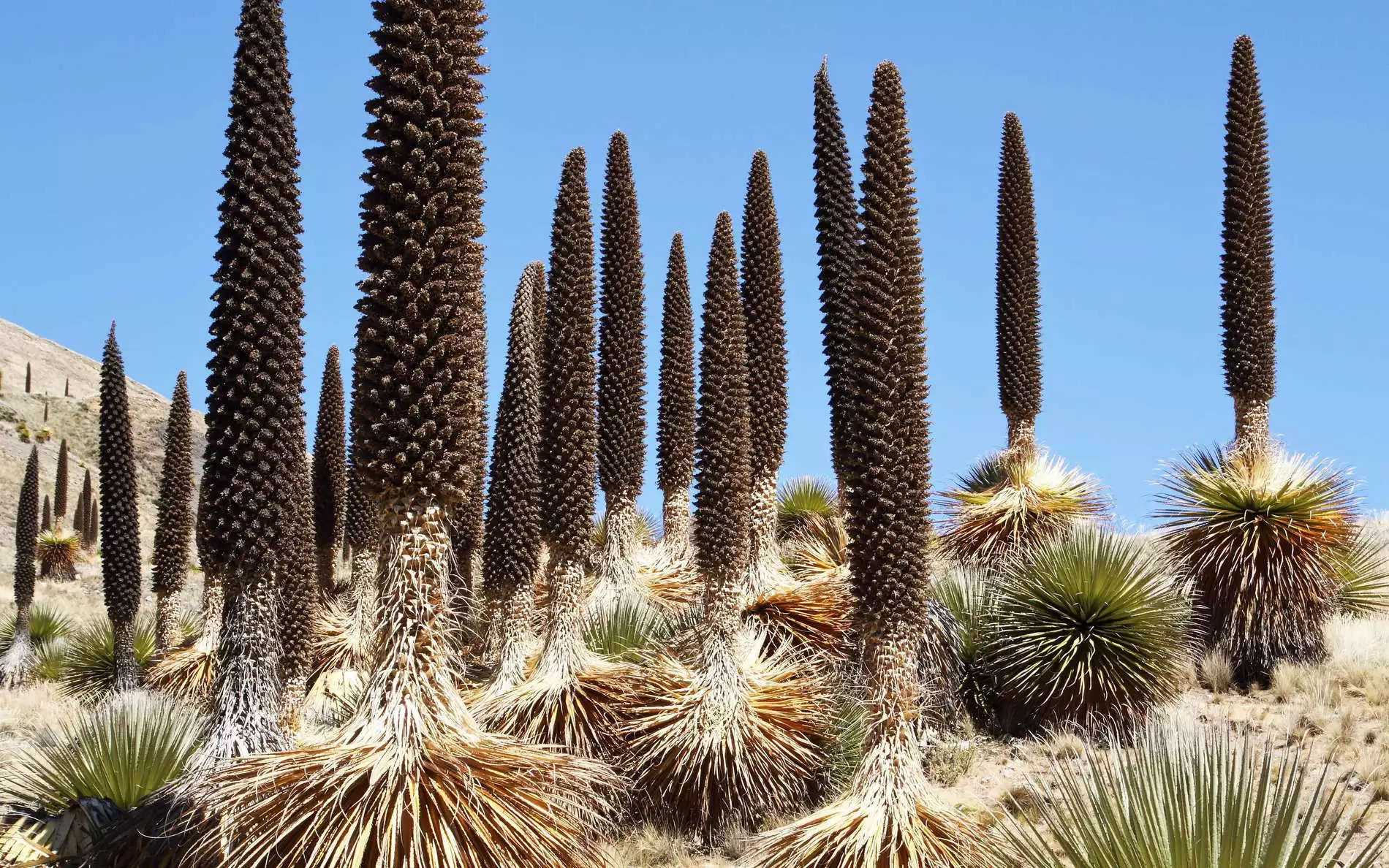
Known as the queen of the Andes, Puya raimondii is the largest species of bromeliad and can grow up to 15 meters tall. This plant species is found in Bolivian and Peruvian forests in the high Andes. Its flowers can grow up to 30 feet (9.14 m) tall and contain 8-12 million seeds per plant. Unfortunately, in the wild, the queen of the Andes has only three populations and has lower genetic diversity compared to the thousands of other species in the bromeliad group. Puya raimondii is currently on the brink of extinction due to its inability to adapt to climate change and deforestation.
6. Sunflowers

Sunflowers, which are mainly native to North and South America, are often cultivated on farms due to their impressive flower size and edible seeds that can be used to make sunflower oil or roasted for consumption. In order to maximize their growth potential, sunflowers require at least 6-8 hours of direct sunlight per day. The oversized blooming of sunflowers is truly breathtaking, with some Russian varieties boasting flowers up to 14 inches in diameter on towering stems reaching 9 to 12 feet in height. Farmers typically sow sunflower seeds in spring and harvest the crop at the end of summer. It is worth noting that the sunflower is considered the largest flower in the world in terms of its usability.
7. Tree peony
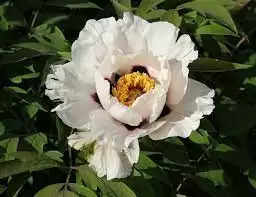
The tree peony, a larger variant of the common peony, is a unique plant with distinct characteristics. Unlike the common peony, tree peonies are woody shrubs that can grow as tall as 10 feet without any support. These plants come in a variety of forms, colors, and fragrances, and their flowers are larger and typically bloom earlier than those of herby peonies. In China, tree peonies are used for decorative purposes as well as for medicinal uses.
8. Hibiscus
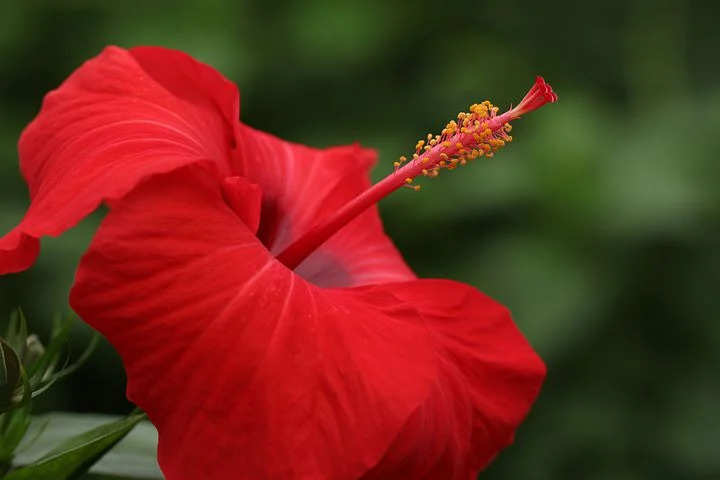
Hibiscus, also known as Hibiscus sabdariffa, is renowned for its large, vibrant flowers, making it an excellent choice for adding beauty to gardens and homes. However, it is also valued for its medicinal properties. The flowers come in various colors, including red, yellow, white, and peach, and can grow up to 8 inches in diameter. The hibiscus family comprises a variety of plants, ranging from annuals and perennials to shrubs, all known for their spectacular and bold blooms, often the size of a plate.
9. Magnolia
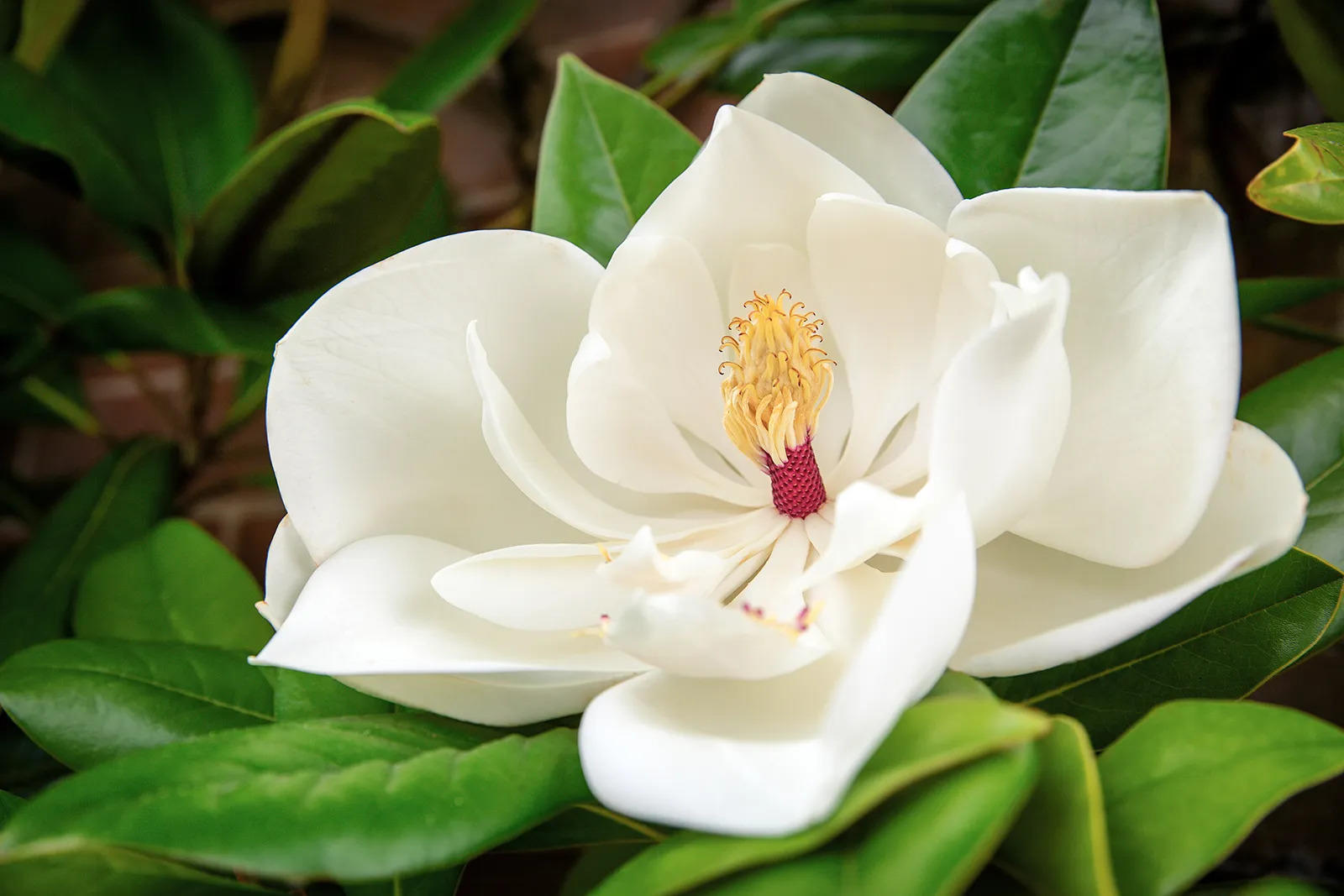
According to many researchers, the first flowering plant on Earth is also believed to be one of the largest. Scientific research based on fossils indicates that magnolias have been around for about 100 million years. Due to its age, magnolia flowers do not have true petals and sepals but have tepals that resemble petals. While not producing nectar, the fragrant and sweet secretions of magnolia flowers attract pollinating beetles. Magnolia flowers come in various shapes, sizes, and colors, and the magnolia family includes tall trees with fluffy blossoms in pink, white, red, purple, and yellow. Most magnolia species have wide bulbs that can reach a diameter of 6 to 8 inches.
10. Lotus
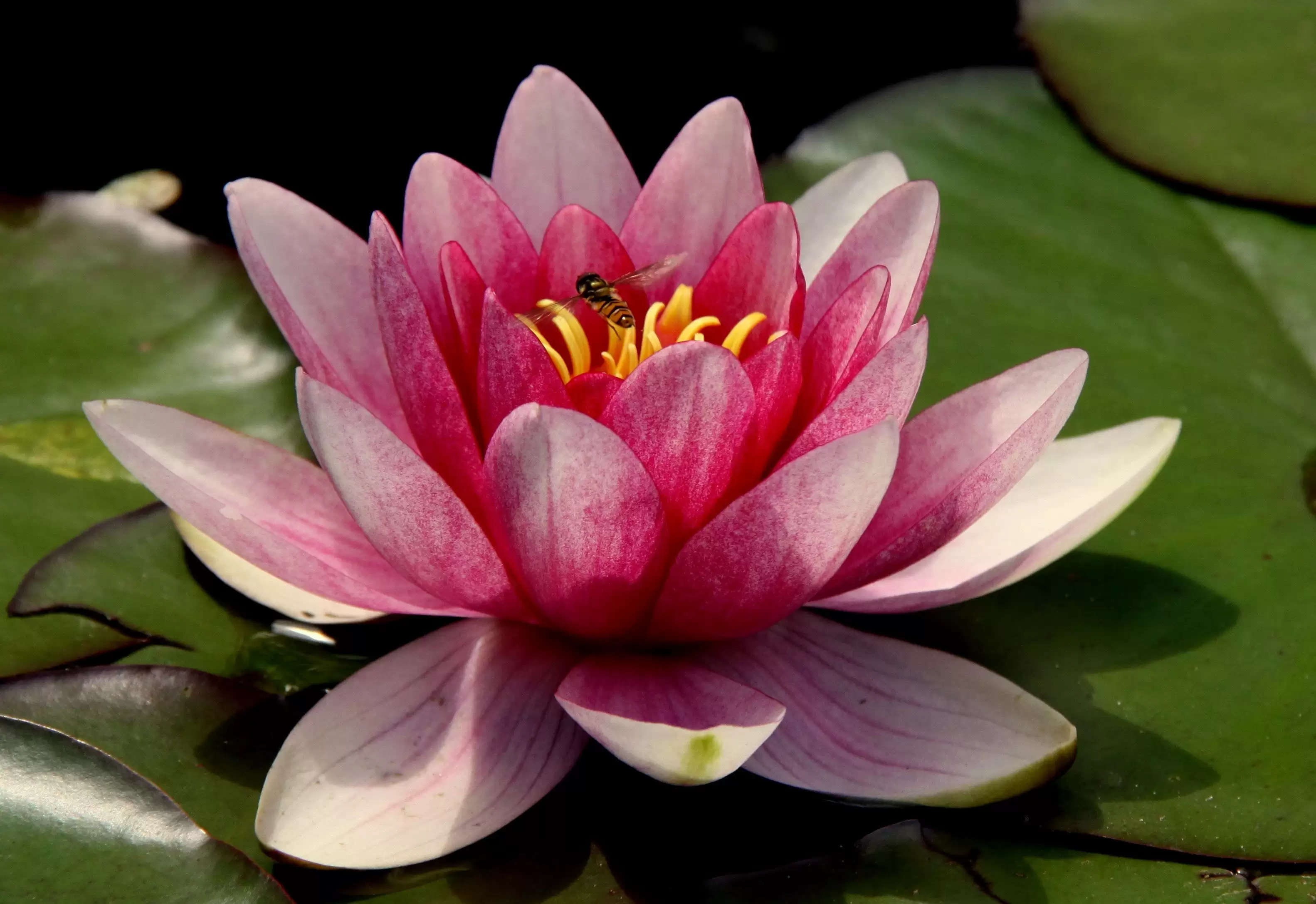
The lotus flower is revered as one of the most sacred and recognizable flowers in the world, not only for its aesthetic appeal but also for its cultural and spiritual significance. In India, it is the national flower and frequently used in religious ceremonies. The color of the flower holds immense value as well. The white and pink lotus flowers from the Nelumbo family are considered sacred and symbolize purity and devotion, while the bright red, purple, and blue flowers represent enlightenment, renaissance, and spiritual awakening. Lotus flowers thrive in warm and shallow waters, but they cannot survive in cold climates. These aquatic flowers have their roots deeply embedded in the mud at the bottom of still waters, with short twigs growing up into the water and waxy waterproof leaves resting on or above the water's surface. When fully matured, the lotus flower's bloom can reach a diameter of up to 20 centimeters (7 inches) above the water's surface, adding a touch of serenity and grace to any setting. The lotus flower's unique beauty and spiritual significance make it a perfect choice for any occasion, according to many.



